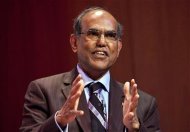By Shamik Paul and Tony Munroe
MUMBAI (Reuters) - The Reserve Bank of India (RBI) left
interest rates on hold on Tuesday but cut the cash reserve ratio for
banks, defying pressure from the government to lower rates for the first
time since April but also indicating it may soon ease policy further. While the decision to leave the policy repo rate
unchanged at 8.00 percent was in line with forecasts in a recent Reuters
poll, expectations for a rate cut had grown after Finance Minister P.
Chidambaram on Monday outlined a plan to trim the country's hefty fiscal
deficit.
While the decision to leave the policy repo rate
unchanged at 8.00 percent was in line with forecasts in a recent Reuters
poll, expectations for a rate cut had grown after Finance Minister P.
Chidambaram on Monday outlined a plan to trim the country's hefty fiscal
deficit."As inflation eases further, there will be an opportunity for monetary policy to act in conjunction with fiscal and other measures to mitigate the growth risks and take the economy to a sustained higher growth trajectory," RBI Gov. Duvvuri Subbarao wrote in his quarterly policy review.
(Read expert views on RBI review, click http://in.reuters.com/article/2012/10/30/rbi-policy-review-repo-rate-idINDEE89T03920121030)
Headline wholesale price index inflation rose to 7.8 percent in September, a 10-month peak, and the RBI said it expects inflation to rise before easing in the final quarter of the fiscal year, which ends in March.
"While risks to this trajectory remain, the baseline scenario suggests a reasonable likelihood of further policy easing in the fourth quarter of 2012-13," Subbarao wrote.
The market had been positioned for a rate cut, said A. Prasanna, economist at ICICI Securities Primary Dealership.
"There's a positive that RBI has said there's a likelihood of easing in the Jan-March quarter. Looks like RBI wants inflation to peak out before cutting rates so we shouldn't expect anything in December. We expect a 50 basis points cut during Jan-March," he said.
India's 10-year bond yield rose around 4 basis points, while the rupee and stocks weakened.
Investors, companies and the government have been clamouring for a cut to interest rates that have been on hold since April and remain some of the highest among major economies.
"A rate cut in the face of jump in September WPI, sharp upward revision to historical numbers and recent rebound in the proxy core inflation measure, might have put the bank's inflation-fighting credibility at risk," said Radhika Rao, an economist at Forecast Pte in Singapore.
While economic growth in India has been slowing, inflation has not, and the RBI has been calling on the government to follow through quickly on recent steps to cut its deficit and encourage investment, and to take further such measures.
"Recent policy announcements by the government, which have positively impacted sentiment, need to be translated into effective action to convert sentiment into concrete investment decisions," Subbarao wrote.
Chidambaram on Monday outlined a plan to nearly halve the deficit in just over four years. While he gave few specifics, his announcement at a hastily called news conference was seen as adding pressure on the RBI to cut rates.
New Delhi has unveiled a spate of reforms to bolster investment and rein in its fiscal deficit, including raising the price of subsidised diesel and lifting caps on foreign investment in several industries.
The RBI cut its GDP growth forecast for Asia's third-largest economy to 5.8 percent for the current fiscal year, from 6.5 percent previously, and increased its projection for headline inflation in March to 7.5 percent, from 7 percent earlier.
The RBI lowered the cash reserve ratio, the amount of deposits that banks must keep with the central bank, by 25 basis points to 4.25 percent, a move it said would inject about 175 billion rupees into the banking system in order to pre-empt potentially tightening liquidity.
In the Reuters poll earlier this month, economists had been nearly evenly split on whether or not the RBI would lower CRR.

